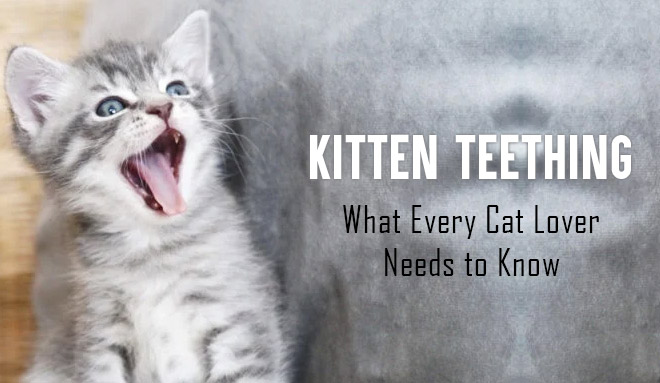While young people must wait years to lose all of their baby teeth and have their adult teeth emerge, kittens go through the teething process much more swiftly. Before they reach their sixth month of age, cats really go through two sets of teeth.

As a result, kittens experience teething twice throughout their lives: once for their set of 26 baby teeth and once more when their 30 adult teeth erupt. While a kitten may experience some soreness as their sharp new teeth erupt from their gums during the teething process, most kittens do not experience pain. As they go through the teething phase, kittens will not chew as haphazardly as puppies do.
Do you think your kitten has started chomping on everything in sight—including your arm? She is teething, and her adult teeth are beginning to appear. Here are all the answers to your questions regarding the developing pains of your young tiger.
When do kittens start teething?
Your kitten’s first stage of teething begins when she gets her deciduous teeth between the ages of two and six weeks. Although the eruption of the baby teeth is typically quite uneventful, you might notice the kittens nibbling on their toys more than normal.
When the adult teeth erupt, it is when teething really gets going. This typically begins at three months of age, and by six or seven months, all of the adult teeth are in place.
How to determine if your kitty is teething?
The following are some indications that your kitty has started the teething process:
Signs Your Kitten Is Teething
- Missing teeth: You might find missing teeth on your floor or you might never find them at all. Fear not; swallowing baby teeth is typical in cats and poses no health risks.
- Pawing at Mouth: Your kitten may be trying to remove a loose tooth by shaking its head and pawing at the mouth.
- Excessive Chewing: The strain from the teeth erupting is relieved to some extent by increased chewing.
- Irritating Behaviour: Due to their painful mouth and gums, kittens are sometimes more irritable and grouchy.
- Appetite suppression: If your kitten’s hunger has decreased, try feeding them canned food, which is much simpler for them to chew.
- Gum Bleeding: You can notice blood specks in their food or drink bowls due to slight gum bleeding.
- Sensitive Face: It refers to how sensitive their face is to touch.
- Less Grooming: Reduced grooming behaviour is a common indicator that your cat’s mouth hurts.
How you can help your teething kitten feel better?
Fortunately, you have a range of solutions for relieving your teething kitten’s discomfort. You might try to:
- Offer soft food, like as kibble soaked in warm water or a tinned diet.
- Make sure she has a lot of interactive playtime with you so that she can be entertained and worn out.
- Prepare some low-sodium chicken broth or diluted tuna juice in the form of ice cubes for her to play with and chew on. The ice will calm the gums’ irritation. This is particularly well-liked when it’s scorching outside!
- Give your pet safe chew toys and cat grass for snacking.
The majority of pain is mild and should go away on its own. Make sure to call your veterinarian in case of severe pain. Never administer drugs intended for adult cats or other animals to your kitten! Always speak with your veterinarian before administering any cat dental care products.
When is it necessary to see the vet?
When adult teeth begin to erupt and baby teeth are still present, it can result in issues including fractured teeth and alignment issues. Watch out for signs of dental crowding, such as the presence of two rows, in their mouths.
Red, swollen gums with discharge are one sign of an infection in your kitten’s mouth, and this condition has to be treated by a veterinarian.
Bottom Line
Make sure to shower your cat with lots of affection, support, and patience when these new teeth erupt because they might not manage the teething process well. In general, trust your instincts, and if you have any concerns as a pet parent, call to make an appointment at your local veterinary clinic.

